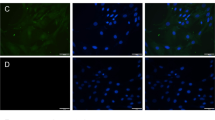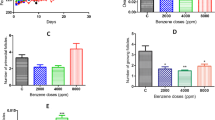Abstract
The aim of this study was to determine the toxic effect of atrazine at the ovarian cellular level. Chinese Hamster Ovary (CHO-K1) cell line was used to evaluate the degree of in vitro atrazine cytotoxicity and the morphological changes were followed during the cell death. Application of four bioassays confirmed that atrazine decreases ovarian cell proliferation and IC50 were determined with each assay after 72 h of exposure. The level of apoptosis in atrazine treated cells was low.



Similar content being viewed by others
References
Cooper RL, Stoker TE, Tyrey L, Goldman JM, McElroy WK (2000) Atrazine disrupts the hypothalamic control of pituitary-ovarian function. Toxicol Sci 53:297–307
Crisp TM, Clegg ED, Cooper RL, Wood WP, Anderson DG, Baetcke KP (1998) Environmental endocrine disruption: an effects assessment and analysis. Environ Health Perspect 106:11–56
Freshney RI (2005) Culture of animal cells: a manual of basic techniques, 5th edn. John Wiley & Sons Inc., Hoboken, NJ
Fujimoto N, Honda H (2003) Effects of environmental estrogenic compounds on growth of a transplanted estrogen responsive pituitary tumor cell line in rats. Food Chem Toxicol 41:1711–1717
Gianessi LP, Marcelli MB (2000) Pesticide use in U.S. crop production: 1997, National Summary report, USDA, Washington DC
Kniewald J, Mildner P, Kniewald Z (1979) Effects of s-trazine herbicides on hormone-receptor complex formation, 5alpha-reductase and 3alpha-hydroxysteroid dehydrogenase activity at the anterior pituitary level. J Steroid Biochem 11:833–838
Kniewald J, Kmetič I, Gaurina Srček V, Kniewald Z (2005) Alternative models for toxicity testing of xenobiotics. Arh Hig Rada Toksikol 56:195–204
Manske MK, Beltz LA, Dhanwada KR (2004) Low-level atrazine exposure decreases cell proliferation in human fibroblasts. Arch Environ Contam Toxicol 46:438–444
National Research Council (1999) Committee on hormonally active agents in the environment. Hormonally active agents in the environment. National Academy Press, Washington
OECD (1993) Guidelines for testing of chemicals, guideline 422: combined repeated dose toxicity study with the reproduction/developmental toxicity screening test. OECD, Paris
O’Hare S, Atterwill CK (eds) (1995) In vitro toxicity testing protocols, methods in molecular biology, vol 43. Humana Press, Totowa, NJ
Peruzović M, Kniewald J, Čapkun V, Milković K (1995) Effect of atrazine ingested prior to mating on rat females and their offsprings. Acta Physiol Hung 83:79–89
Rayburn AL, Moody DD, Freeman JL (2005) Cytotoxicity of technical grade versus formulations of atrazine and acetochlor using mammalian cells. Bull Environ Contam Toxicol 75:691–698
Šimić B, Kniewald J, Kniewald Z (1994) Effects of atrazine on reproductive performance in the rat. J Appl Toxicol 14:401–404
Stoker TE, Robinette CL, Cooper RL (1999) Maternal exposure to atrazine during lactation suppresses suckling-induced prolactin release and results in prostatitis in the adult offspring. Toxicol Sci 52:68–79
Stoker TE, Laws SC, Guidici DL, Cooper RL (2000) The effect of atrazine on puberty in male Wistar rats: an evaluation in the protocol for the assessment of pubertal development and thyroid function. Toxicol Sci 58:50–59
Težak Ž, Šimić B, Kniewald J (1992) Effect of pesticides on oestradiol-receptor complex formation in rat uterus cytosol. Food Chem Toxic 30:879–855
Acknowledgments
This study was supported by Ministry of Science, Education and Sports of the Republic of Croatia, grants no. 0582184-2232 and no. 0582184-2414.
Author information
Authors and Affiliations
Corresponding author
Rights and permissions
About this article
Cite this article
Kmetič, I., Gaurina Srček, V., Slivac, I. et al. Atrazine Exposure Decreases Cell Proliferation in Chinese Hamster Ovary (CHO-K1) Cell Line. Bull Environ Contam Toxicol 81, 205–209 (2008). https://doi.org/10.1007/s00128-008-9425-6
Received:
Accepted:
Published:
Issue Date:
DOI: https://doi.org/10.1007/s00128-008-9425-6




